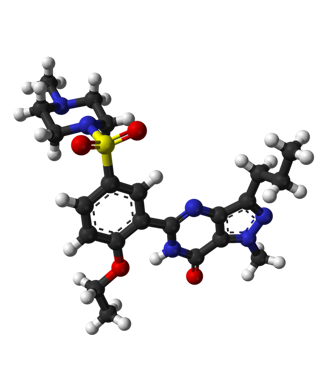Viagra Use Linked With Increased Risk for Melanoma
Men who used sildenafil (Viagra) had an 84% increased risk for developing melanoma, even after adjusting for known risk factors, according to the results of a prospective study.
Ball-and-stick model of sildenafil

Men who used the phosphodiesterase (PDE) 5A inhibitor sildenafil (Viagra) had an 84% increased risk for developing melanoma even after adjusting for known risk factors, according to the results of a prospective study published in JAMA: Internal Medicine.
“Our study cannot prove cause and effect. A longer follow-up and more detailed assessment of the dose and frequency of sildenafil use at multiple times in the Health Professionals’ Follow-Up Study would be necessary for future studies,” wrote researchers, led by Wen-Qing Li, PhD, of Brigham and Women’s Hospital. “Our results should be interpreted cautiously and are insufficient to alter current clinical recommendations.”
The cyclic guanosine monophosphate (cGMP)-specific PDE 5A was recently identified as a downstream target of BRAF, a mutation present in about 50% of melanomas. Prior research has shown that “through the MEK/ERK cascade, activated BRAF down-regulates PDE 5A, which lowers cGMP degradation and leads to an increase in intracellular calcium ion Ca2+, triggering invasion of metastasis of melanoma cells.”
Therefore, Li and colleagues conducted this prospective study to evaluate if sildenafil use was associated with an increased risk for melanoma. They studied 25,848 participants in the Health Professionals’ Follow-up Study, who were questioned in 2000 about their use of sildenafil for erectile dysfunction. The mean age of participants was 64.8 years
During the 10-year study period from 2000 to 2010, 142 cases of melanoma were documented. Additionally, 580 cases of squamous cell carcinoma and 3,030 cases of basal cell carcinoma were diagnosed. Patients who identified as recent sildenafil users at baseline had an 84% increase risk for invasive melanoma (HR = 1.84; 95% CI, 0.59-1.20) after adjusting for other risk factors such as number of moles, natural hair color, lifetime number of sunburns, and a family history of melanoma.
No similar association was found for squamous cell or basal cell carcinoma, and erectile dysfunction itself was not associated with an increased risk for melanoma. Ever use of sildenafil was also associated with an increased risk for melanoma (HR = 1.92; 95% CI, 1.14-3.22).
To explore further, the researchers conducted a second analysis that excluded all participants with a major chronic disease at baseline, leaving 79 melanoma cases among 14,912 participants. These participants had a hazard ratio of 2.24 for invasive melanoma for recent use of sildenafil (95% CI, 1.05-4.78) and of 2.77 for ever use (95% CI, 1.32-5.85).
In an editorial that accompanied the article, June K. Robinson, MD, of the department of dermatology, Northwestern University Feinberg School of Medicine, wrote that a prospective study is needed before any recommendation can be made to change men’s use of sildenafil.
“From 1975 through 1986, the annual percentage increase in men’s age-adjusted incidence rate of melanoma was 5.6%. This slowed to 2.4% per year from 1992 to 2010,” Robinson wrote. “Sildenafil received approval for the treatment of erectile dysfunction on March 27, 1998. The rate of increase in melanoma in men slowed as sildenafil came into use, which raises a cautionary note about the influence of sildenafil in the development of melanoma, but its role in the biologic behavior of melanoma in older men warrants further study.”
However, she also pointed out that since melanoma prevention is vital and the population of men aged 65 years and older will continue to increase during the next decade that primary care physicians could begin to perform basic skin checks of a patient’s face, bald scalp, ears, and neck when a sildenafil prescription is requested or required.